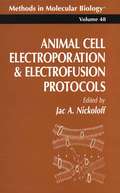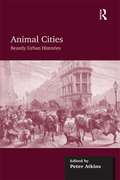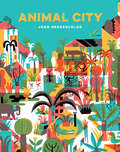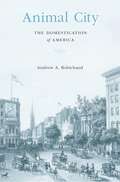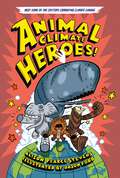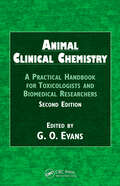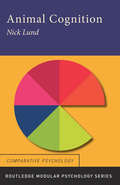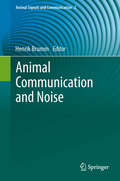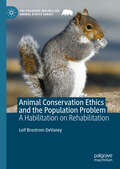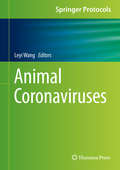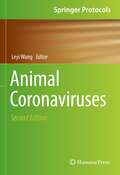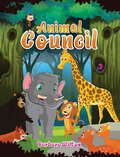- Table View
- List View
Animal Cell Electroporation and Electrofusion Protocols (Methods in Molecular Biology #48)
by Jac A. NickoloffThis superb collection of well-tested protocols for the electroporation of proteins and DNA into insect, fish, and mammalian cells also includes proven animal cell electrofusion techniques for studies of somatic cell genetics and development, and for generating monoclonal antibodies. It is distinguished by its coverage of important model cell types from many organisms and tissue types and its detailed instructions for the growth and preparation of specific cells to achieve optimum transfection. Its extensive reference lists, citations of alternative transfer methods, advice on pitfalls to avoid, and descriptions of expected results ensure readily reproducible results even for beginners.
Animal Cities: Beastly Urban Histories
by Peter AtkinsAnimal Cities builds upon a recent surge of interest about animals in the urban context. Considering animals in urban settings is now a firmly established area of study and this book presents a number of valuable case studies that illustrate some of the perspectives that may be adopted. Having an ’urban history’ flavour, the book follows a fourfold agenda. First, the opening chapters look at working and productive animals that lived and died in nineteenth-century cities such as London, Edinburgh and Paris. The argument here is that their presence yields insights into evolving understandings of the category ’urban’ and what made a good city. Second, there is a consideration of nineteenth-century animal spectacles, which influenced contemporary interpretations of the urban experience. Third, the theme of contested animal spaces in the city is explored further with regard to backyard chickens in suburban Australia. Finally, there is discussion of the problem of the public companion animal and its role in changing attitudes to public space, illustrated with a chapter on dog-walking in Victorian and Edwardian London. Animal Cities makes a significant contribution to animal studies and is of interest to historical geographers, urban, cultural, social and economic historians and historians of policy and planning.
Animal City
by Joan NegrescolorNina journeys to a secret jungle city populated by animals, plants, and lost objects. The reason for her visit: story hour, where a book's power holds the wild in thrall. The animals are eager for stories about space, the sea, and other worlds. But their favorite story of all is the one told here: a story about a mysterious place, laden with legend and lore, and now overtaken by nature. Five Pantone colors infuse each illustrated spread with a vibrant, electric energy, making this powerful celebration of nature—and stories—as vivid visually as its narrative is engrossing.
Animal City: The Domestication of America
by Andrew A. RobichaudAmerican urbanites once lived alongside livestock and beasts of burden. But as cities grew, human–animal relationships changed. The city became a place for pets, not slaughterhouses or working animals. Andrew Robichaud traces the far-reaching consequences of this shift—for urban landscapes, animal- and child-welfare laws, and environmental justice.
Animal Climate Heroes
by Alison Pearce StevensIn our left corner we have the meanest villain that’s ever existed. Responsible for rising seas and loss of biodiversity, it’s climate change ready to wreak havoc on the Earth. But in our right corner? We have four superheroes ready to save the day!Forest elephants protect our forests by trampling trees.Whales boost ocean health with their massive poo-nados.Sea otters defend kelp forests from purple invaders.And echidnas bury tons of soil to stop climate change.But we can’t leave them in this fight alone. We need to protect our heroes who, in return, defend our planet. Get ready to learn all about these four legged, and two-flippered, creatures and how YOU can be a climate hero too!
Animal Clinical Chemistry: A Practical Handbook for Toxicologists and Biomedical Researchers, Second Edition
by G. O. Evans10+ Years of Updates Since First EditionNewcomers to the animal clinical chemistry and toxicology fields quickly find that the same rules of human medicine do not always apply. Following in the footsteps of its standard-setting first edition, Animal Clinical Chemistry: A Practical Handbook for Toxicologists and Biomedical Researchers, Second Editio
Animal Cognition (Routledge Modular Psychology)
by Nick LundAnimal Cognition looks at how non-human animals process information from their environment. Nick Lund has written an accessible and engaging account of this area of comparative psychology. The book contains chapters on animal navigation (including homing behaviour and migration), animal communication methods and research into animal language, and attempts to teach language to non-human animals. A chapter on memory includes models of memory in non-human animals and discusses the importance of memory in navigation and foraging behaviour.Animal Cognition is designed to cover the AQA(A) A2 level specification but will also be of interest to undergraduates new to comparative psychology. It is well illustrated and includes a study aids section with examination questions and answers, and key research summaries.
Animal Colors
by Carrie Smith Lori O'DeaAnimals come in many colors. Red, blue, pink, green! Explore the wonderful world of animal colors!
Animal Communication Made Easy: Strengthen Your Bond and Deepen Your Connection with Animals
by Pea HorselyA practical and inspiring introductory guide to communicating with pets and wild animals.Your step-by-step guide to forming a deeper connection with animals.Do you love animals but wish you could understand what they're trying to tell you? Do some of their behaviours leave you baffled?In this book, world-renowned animal communicator Pea Horsley teaches you the essentials of animal communication to enable you to communicate intuitively with the animals you love. Pea leads you through grounding preparation processes to calm your body and release your mind, and then her effective five-step method to create a deep, spiritual connection with your animal.Drawing on her many years of experience teaching people to communicate with both wild and domesticated creatures, Pea's unique blend of exercises, affirmations and meditations will empower you to connect with all living beings.Communicating with animals is fun, profound and healing. It's the best thing you can do for both yourself and your animals, and will transform how you experience life.
Animal Communication Theory
by Ulrich E. StegmannThe explanation of animal communication by means of concepts like information, meaning and reference is one of the central foundational issues in animal behaviour studies. This book explores these issues, revolving around questions such as: • What is the nature of information? • What theoretical roles does information play in animal communication studies? • Is it justified to employ these concepts in order to explain animal communication? • What is the relation between animal signals and human language? The book approaches the topic from a variety of disciplinary perspectives, including ethology, animal cognition, theoretical biology and evolutionary biology, as well as philosophy of biology and mind. A comprehensive introduction familiarises non-specialists with the field and leads on to chapters ranging from philosophical and theoretical analyses to case studies involving primates, birds and insects. The resulting survey of new and established concepts and methodologies will guide future empirical and theoretical research.
Animal Communication and Noise (Animal Signals and Communication #2)
by Henrik BrummThe study of animal communication has led to significant progress in our general understanding of motor and sensory systems, evolution, and speciation. However, one often neglected aspect is that signal exchange in every modality is constrained by noise, be it in the transmission channel or in the nervous system. This book analyses whether and how animals can cope with such constraints, and explores the implications that noise has for our understanding of animal communication. It is written by leading biologists working on different taxa including insects, fish, amphibians, lizards, birds, and mammals. In addition to this broad taxonomic approach, the chapters also cover a wide array of research disciplines: from the mechanisms of signal production and perception, to the behavioural ecology of signalling, the evolution of animal communication, and conservation issues. This volume promotes the integration of the knowledge gained by the diverse approaches to the study of animal communication and, at the same time, highlights particularly interesting fields of current and future research.
Animal Conservation Ethics and the Population Problem: A Habilitation on Rehabilitation (The Palgrave Macmillan Animal Ethics Series)
by Leif Brostrom DeVaneyIn this book, Leif DeVaney brings the traditional philosophical branches of metaphysics and ethics to bear on conservation biology. While many previous attempts at asking and answering ethical questions related to conservation and other environmentally relevant activities exist, few such attempts have engaged adequately with the &“rock bottom&” approach of metaphysics. Through this metaphysically realistic lens, the ontologicalstatus of the population (as well as other ecological &“wholes&”) is challenged. DeVaney argues that individual nonhuman animals are found to have interests that parallel human interests. These include the biotic goals of survival and reproduction, as well as freedom from undue pain and suffering. From an ethical standpoint, the conclusion differs drastically from the dominant consequentialist contention that the good of some can be sacrificed for the supposed greater good of the many. DeVaney initiates the establishment of the subdiscipline of conservation metaphysics, which naturally leads to a theoretically grounded ethic.
Animal Contests
by Ian C.W. Hardy Mark BriffaContests are an important aspect of the lives of diverse animals, from sea anemones competing for space on a rocky shore to fallow deer stags contending for access to females. Why do animals fight? What determines when fights stop and which contestant wins? Addressing fundamental questions on contest behaviour, this volume presents theoretical and empirical perspectives across a range of species. The historical development of contest research, the evolutionary theory of both dyadic and multiparty contests, and approaches to experimental design and data analysis are discussed in the first chapters. This is followed by reviews of research in key animal taxa, from the use of aerial displays and assessment rules in butterflies and the developmental biology of weapons in beetles, through to interstate warfare in humans. The final chapter considers future directions and applications of contest research, making this a comprehensive resource for both graduate students and researchers in the field.
Animal Coronaviruses (Springer Protocols Handbooks)
by Leyi WangThis detailed volume provides diagnosticians and researchers with practical methodologies and approaches to tackle animal coronaviruses. It explores conventional immunohistochemistry, virus neutralization, enzyme-linked immunosorbent assays, expression and purification of recombinant viral proteins, and various molecular assays, including conventional and real-time reverse transcription-PCR, reverse genetics methodology, and next generation sequencing and sequence analyses. As part of the Springer Protocols Handbooks series, chapters contain readily reproducible laboratory protocols as well as expert tips on troubleshooting and avoiding known pitfalls. Practical and authoritative, Animal Coronaviruses serves as an ideal reference for researchers examining a wide variety of coronavirus species in the Coronaviridae.
Animal Coronaviruses (Springer Protocols Handbooks)
by Leyi WangThis detailed new edition compiles fully updated practical methodologies and approaches for diagnosticians and researchers working toward a better understanding of animal coronaviruses. The book explores vital techniques in virus isolation, diagnostic approaches via the detection of viral nucleic acids or proteins, serology, disease-targeted animal species models, and next-generation sequencing and bioinformatics. Written for the invaluable Springer Protocols Handbooks series, chapters contain readily reproducible laboratory protocols as well as expert tips on troubleshooting and avoiding known pitfalls. Thorough and hands-on, Animal Coronaviruses, Second Edition will help readers design and carry out their increasingly important projects in clinical research, diagnostics, disease surveillance, and epidemiological study involving this family of viruses.
Animal Council
by Barbara WiltonImagine yourself in the forest wilds. If you saw some animals grouped together, what would you wonder? What are they talking about? Do they plan and discuss things just like people? There must be issues that confront animals that people don’t even think about. Just like people, every animal has a talent to contribute to the group. Which ones are the most valuable because they get the best results? Is it the big, powerful ones like the elephant and the lion, or the less noticed, unexpected ones? Take yourself on a journey to the forest and discover what really goes on.
Animal Crossings (Fountas & Pinnell Classroom, Guided Reading)
by Nico AtwaterNIMAC-sourced textbook
Animal Cruelty Investigations: A Collaborative Approach from Victim to Verdict
by Linda Fielder Emily Lewis Kris OttemanAnimal Cruelty Investigations: A Collaborative Approach from Victim to Verdict provides a framework for the experts who respond to animal cruelty cases: veterinarians, law enforcement agencies, animal care and control organizations, and prosecutors. This book is a practical guide which provides insight and direction for every phase of an animal cruelty investigation. The step-by-step guidance on responding to particular issues and challenges related to animal cruelty cases is bolstered by the extensive library of checklists, form templates, specific case protocols, and lists of available resources. This book is designed to empower readers to respond to animal cruelty cases confidently and effectively by: Introducing veterinarians to their critical role in animal cruelty investigations including forensic examination and necropsy, crime scene response, report writing, and testimony. Included are detailed Specific Case Protocols for common animal cruelty scenarios. Helping animal shelters navigate the challenges of holding animals in protective custody, housing unusual species, and placing evidence animals in foster care. Offering law enforcement agencies useful methods for investigating animal cruelty such as search and seizure protocols, witness interview techniques, and valuable forms and templates necessary to strengthen and ensure proper search warrant execution, evidence collection and handling, and chain of custody; all with a focus on animals as both victims and evidence. Guiding prosecutors through the steps necessary to utilize the veterinarian’s findings during trial and providing insight into issues to be considered when reviewing search warrants, filing charges, proposing plea agreements, or filing pre-conviction forfeiture motions. This book is a must-have reference and guide for veterinarians, technicians, law enforcement officers, prosecutors, and all those involved in the protection of animals’ health and wellbeing. The successful investigation of animal crimes relies on each of these disciplines, not only carrying out their professional duties, but having a collective understanding of what each other needs in order to meet that expectation.
Animal Cruelty, Antisocial Behaviour and Aggression
by Eleonora GulloneDemonstrating that animal cruelty behaviours are another form of antisocial behaviour, alongside human aggression and violence, and almost without exception are carried out by the same individuals this book offers clear recommendations for future research on animal cruelty and future action aimed at prevention.
Animal Dads
by Sneed B. Collard IIIA good book for children describing many types of animals and how their dads play a part of their lives, including the seahorse who actually gives birth to the little seahorse babies.
Animal Diversity
by Allan Larson Susan Keen Cleveland Hickman David Eisenhour Larry RobertsThis text provides a concise introduction to the field of animalbiology. Readers discover general principles of evolution, ecology, animal bodyplans, and classification and systematics. After these introductory chapters,readers delve into the biology of all groups of animals. The basic features ofeach group are discussed, along with evolutionary relationships among groupmembers. Chapter highlights include newly discovered features of animals asthey relate to ecology, conservation biology, and value to human society.Regular updates to the phylogenies within the book keep it current.
Animal Diversity
by Glencoe Mcgraw-HillDiscover the Flexibility to Teach Science Your Way!. "Glencoe Science: Animal Diversity," a module in the Glencoe Science 15 book series, provides students with accurate and comprehensive coverage of middle school National Science Education Standards. Concepts are explained in a clear, concise manner, and are integrated with a wide range of hands-on experiences, critical thinking opportunities, real-world applications, and connections to other sciences and to non-science areas of the curriculum. Co-authored by National Geographic, unparalleled graphics reinforce key concepts. A broad array of print and technology resources help differentiate and accommodate all learners. The modular approach allows you to mix and match books to meet your specific curriculum needs.
Animal Diversity and Biogeography of the Cuatro Ciénegas Basin (Cuatro Ciénegas Basin: An Endangered Hyperdiverse Oasis)
by Fernando Álvarez Margarita OjedaThis volume investigates the contemporary fauna that inhabit the Cuatro Ciénegas Basin. Divided into 15 chapters, it addresses and describes their diversity, taxonomic and biogeogaphic affinities, and ecological characteristics. The Cuatro Ciénegas Valley is a unique oasis in the south-central region of the State of Coahuila, part of the Sonoran Desert, in Mexico. Several clues, specially derived from the study of the microbiota, suggest a very ancient origin of the valley and its permanence through time. This condition had promoted a high level of endemism and led to unique interactions between the resident species.
Animal Diversity of Pakistan: Distribution and Conservation
by Muhammad Ashraf Masroor Elahi BabarThis book presents principles of animal biodiversity, its importance, sustainable utilization, and conservation. The introductory chapter explores the origins and evolution of biodiversity throughout time, shedding light on the remarkable developments that have taken place over the ages. The subsequent chapters of the book reveal the tools and techniques used to assess the status of biodiversity at any given stage. The book meticulously details the indicators and measurement methods employed to gauge the health and vitality of biodiversity. Furthermore, it elucidates the vital role biodiversity plays in serving humanity and underscores the dire consequences that may ensue if we fail to preserve it. It also introduces the nomenclature of species and explores their intricate phylogenetic relationships with both living and non-living entities. The spatial and temporal distribution of animals, unraveling the fascinating patterns and dynamics that govern their presence across the globe, is also discussed in the book. Additionally, the book unveils a repertoire of conservation methods aimed at preserving existing biodiversity and ensuring its sustainable future. Toward the end, the book offers valuable suggestions and highlights untapped avenues for future research, all geared toward safeguarding the current level of biodiversity and ensuring its prosperity in the years to come. This book is a valuable source for students and professionals in the fields of biology, ecology, and conservation biology.
